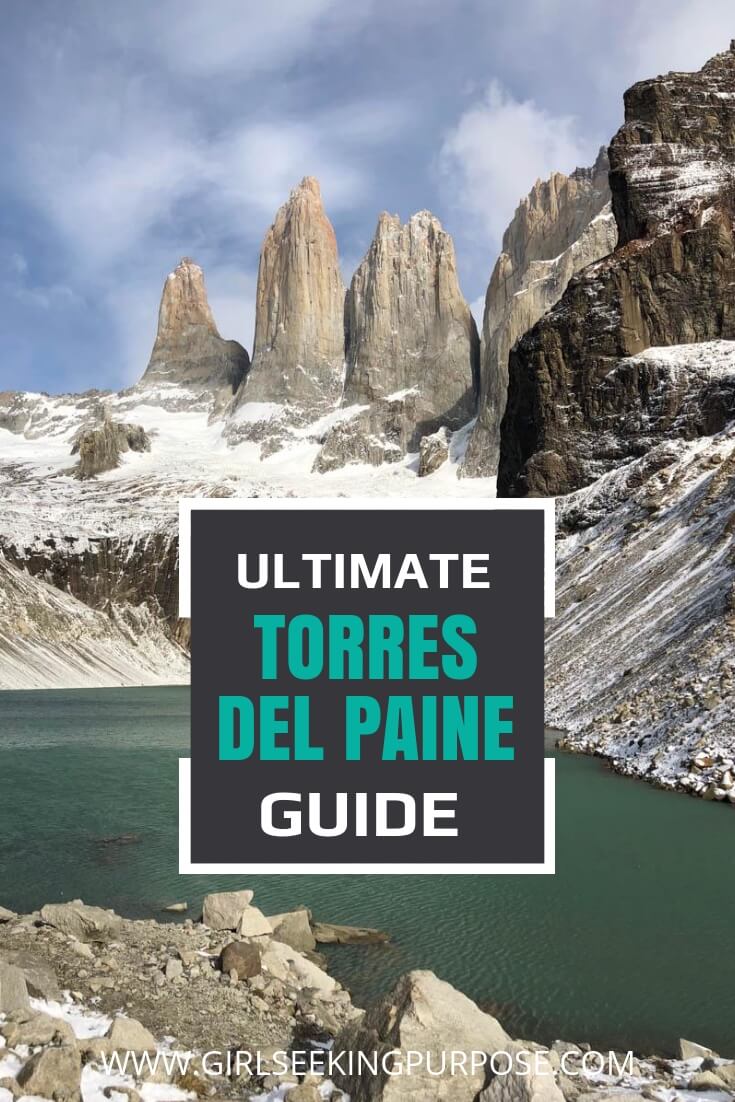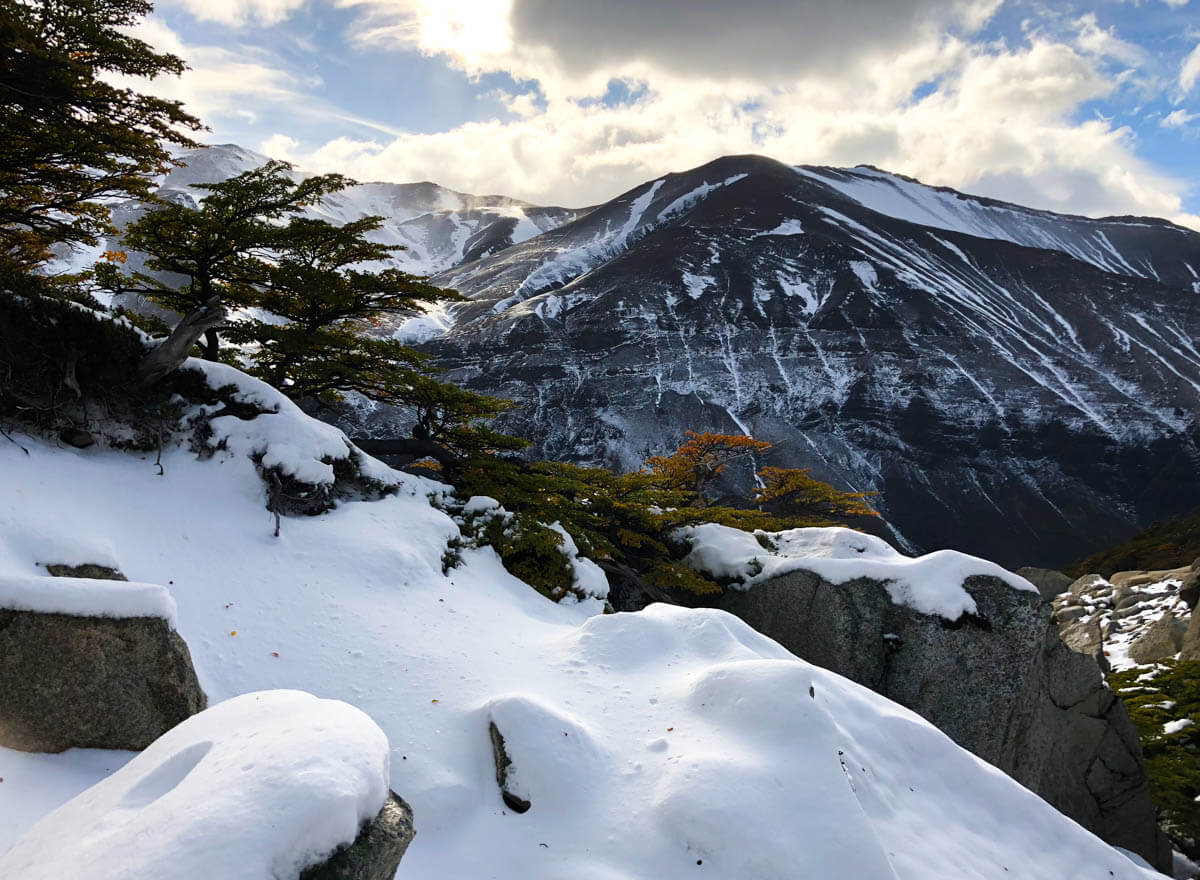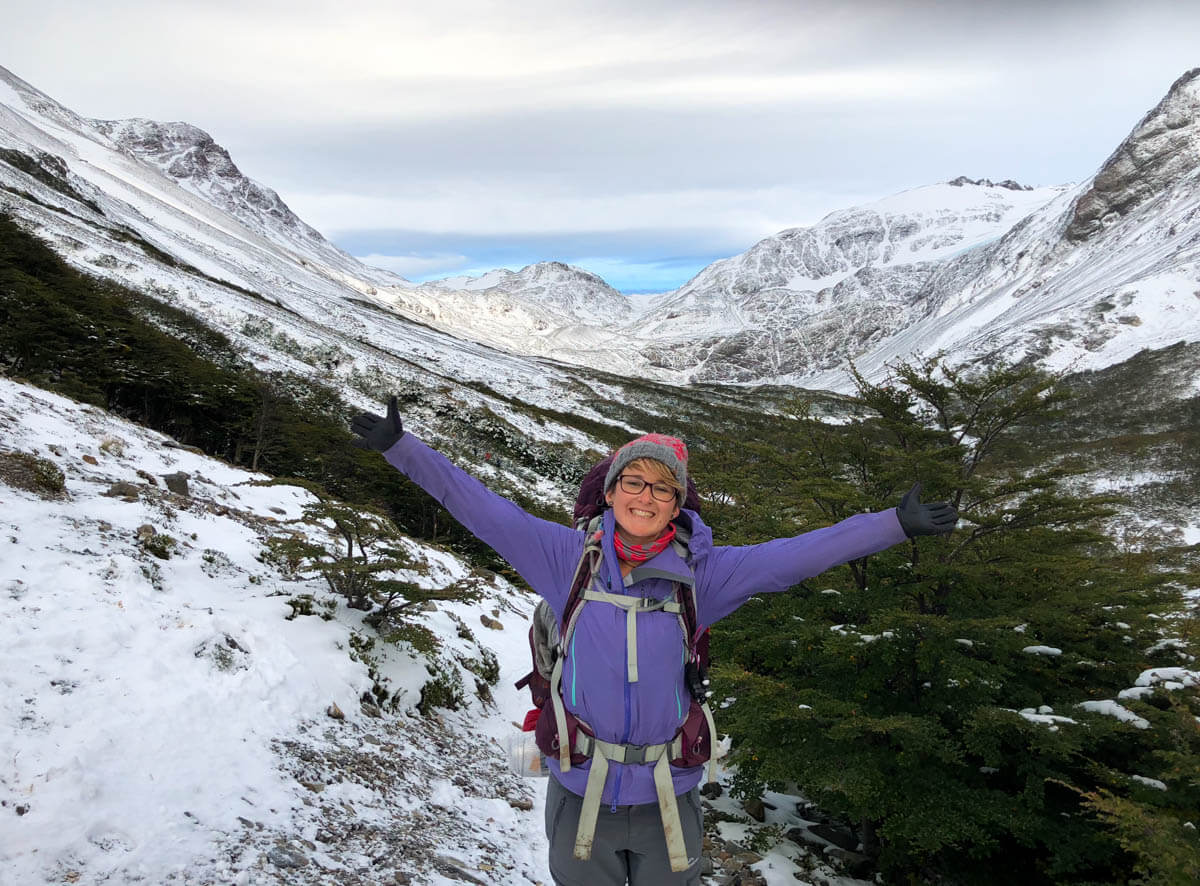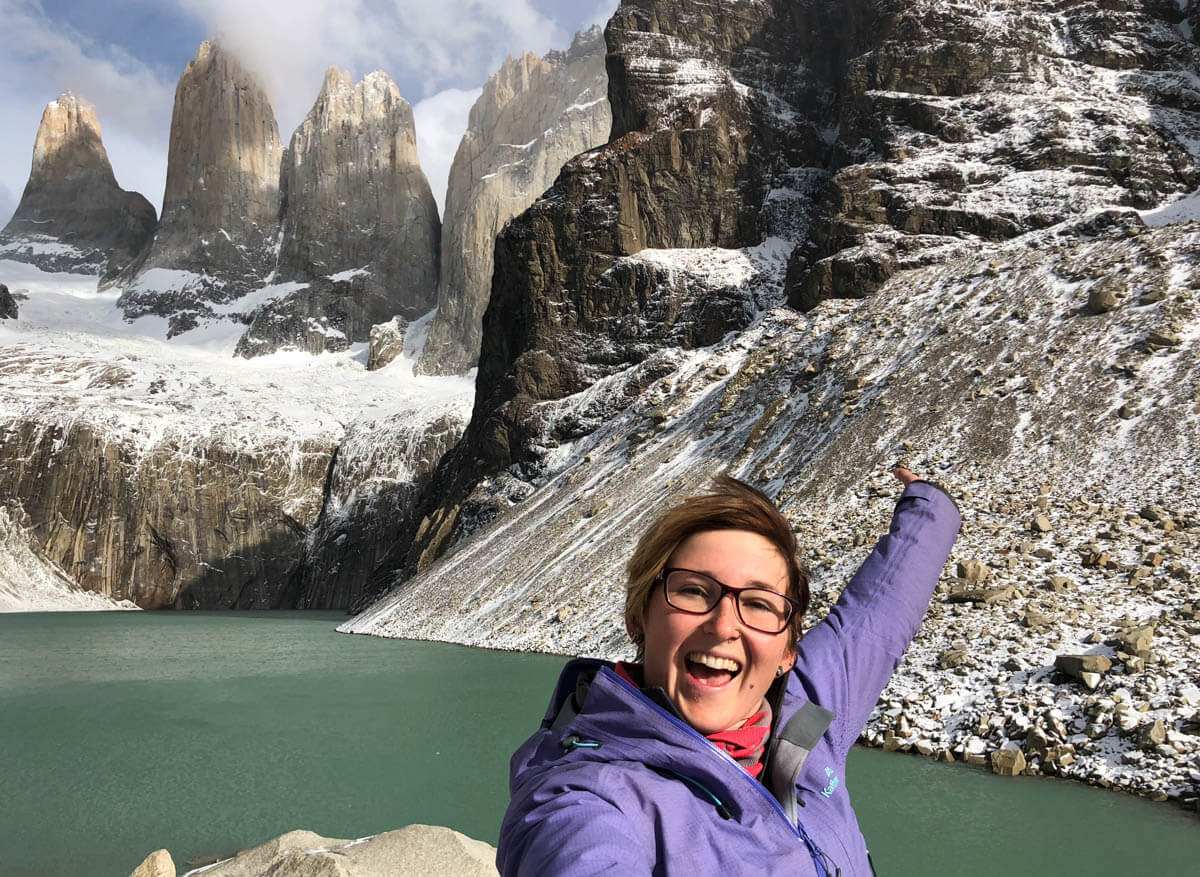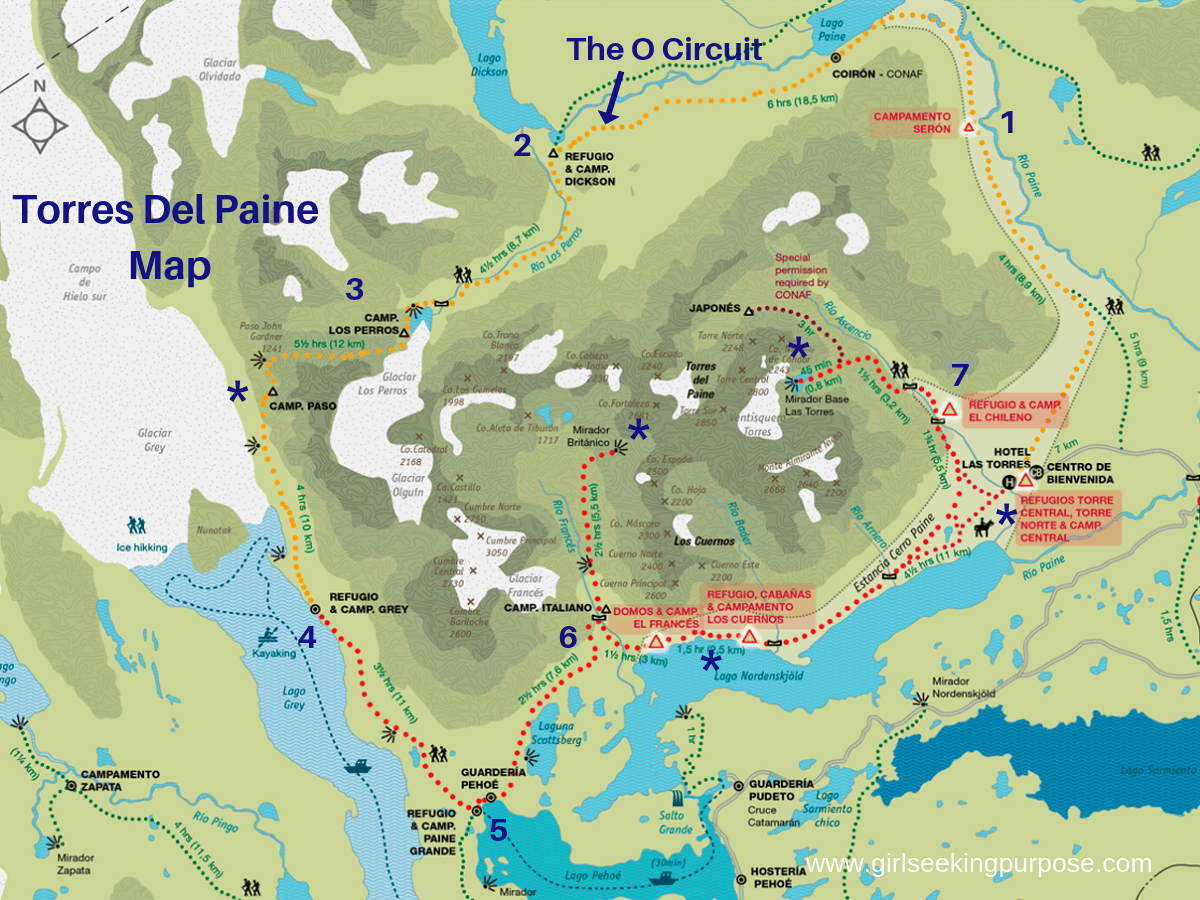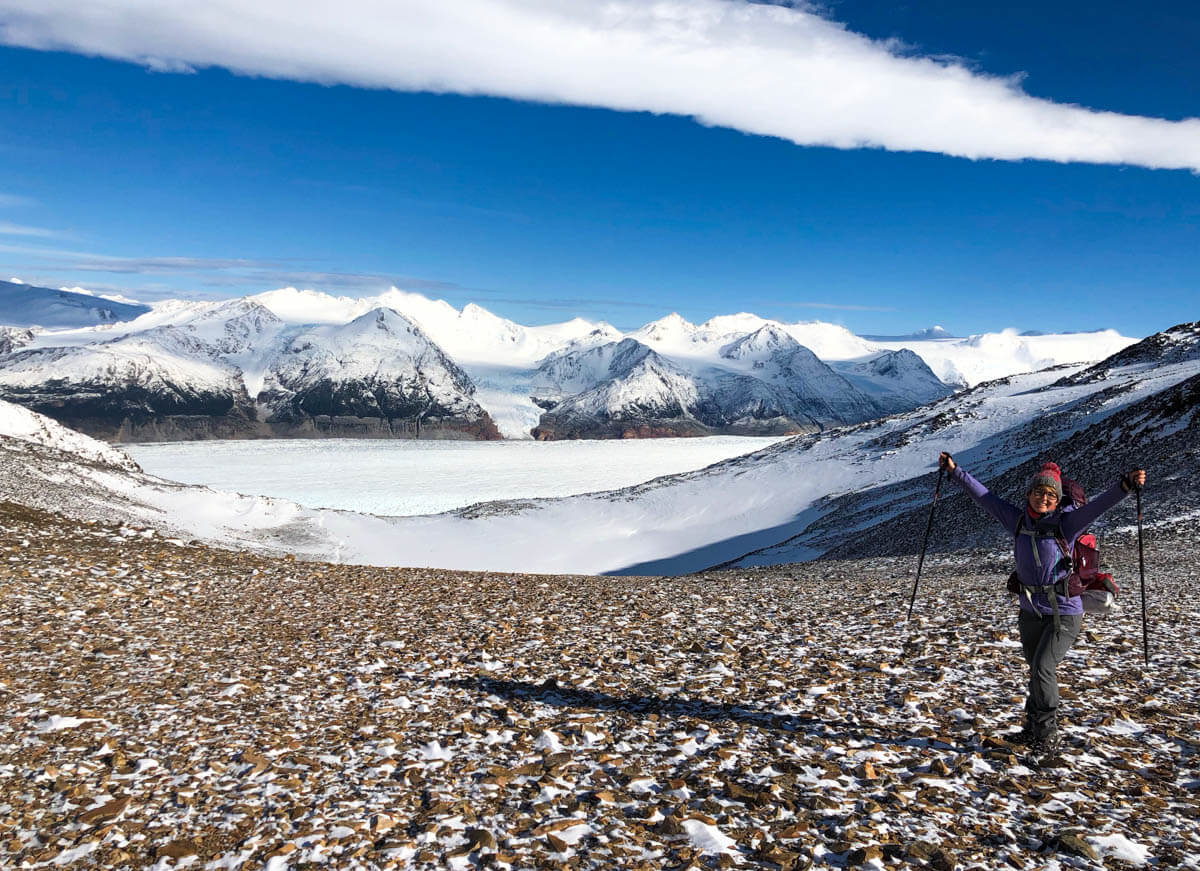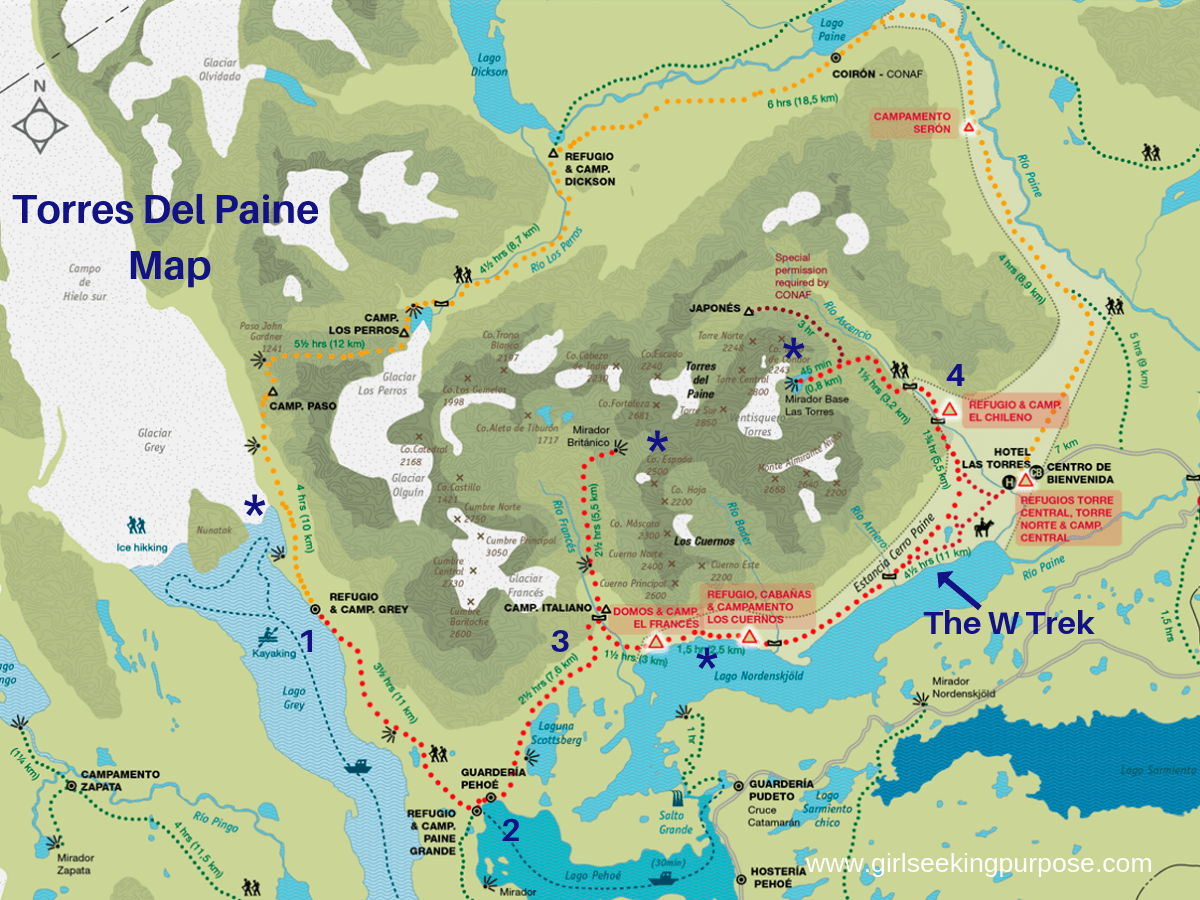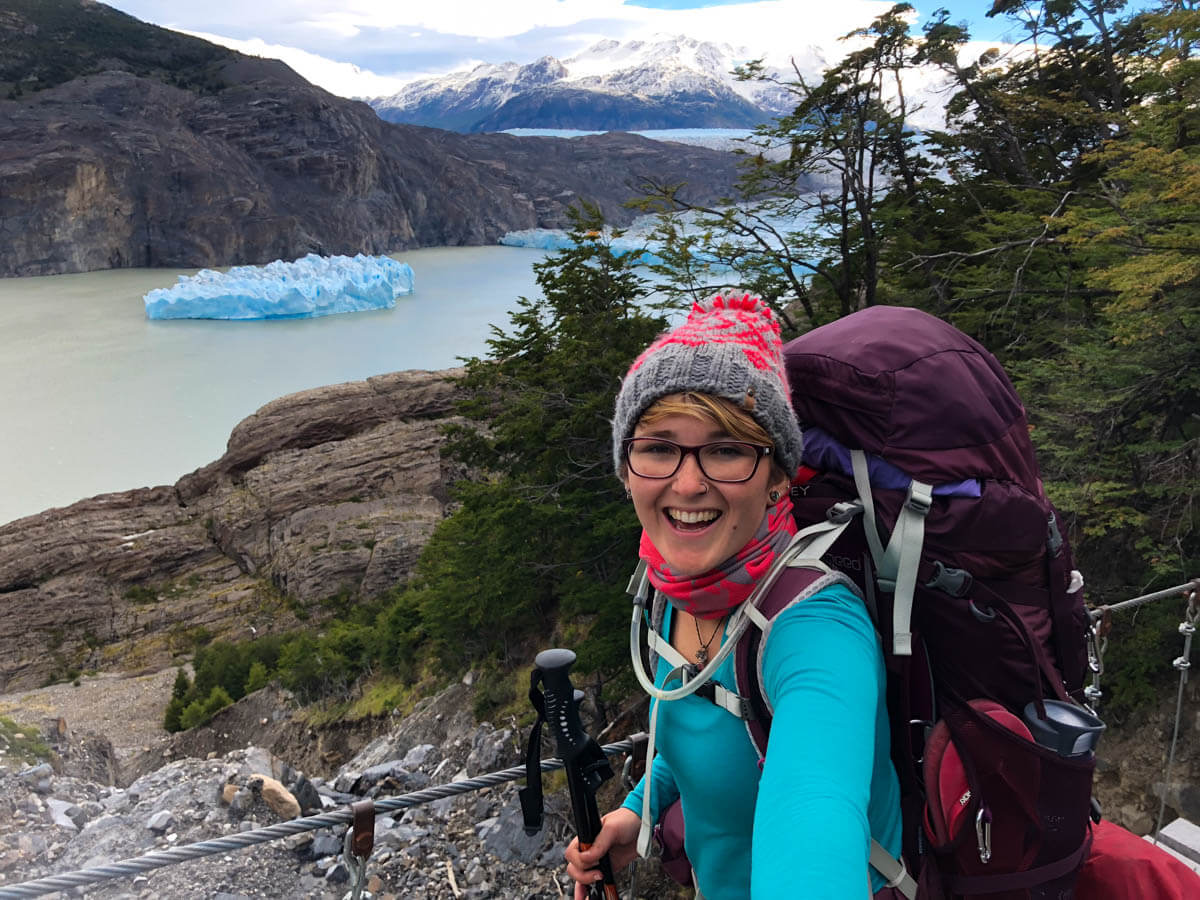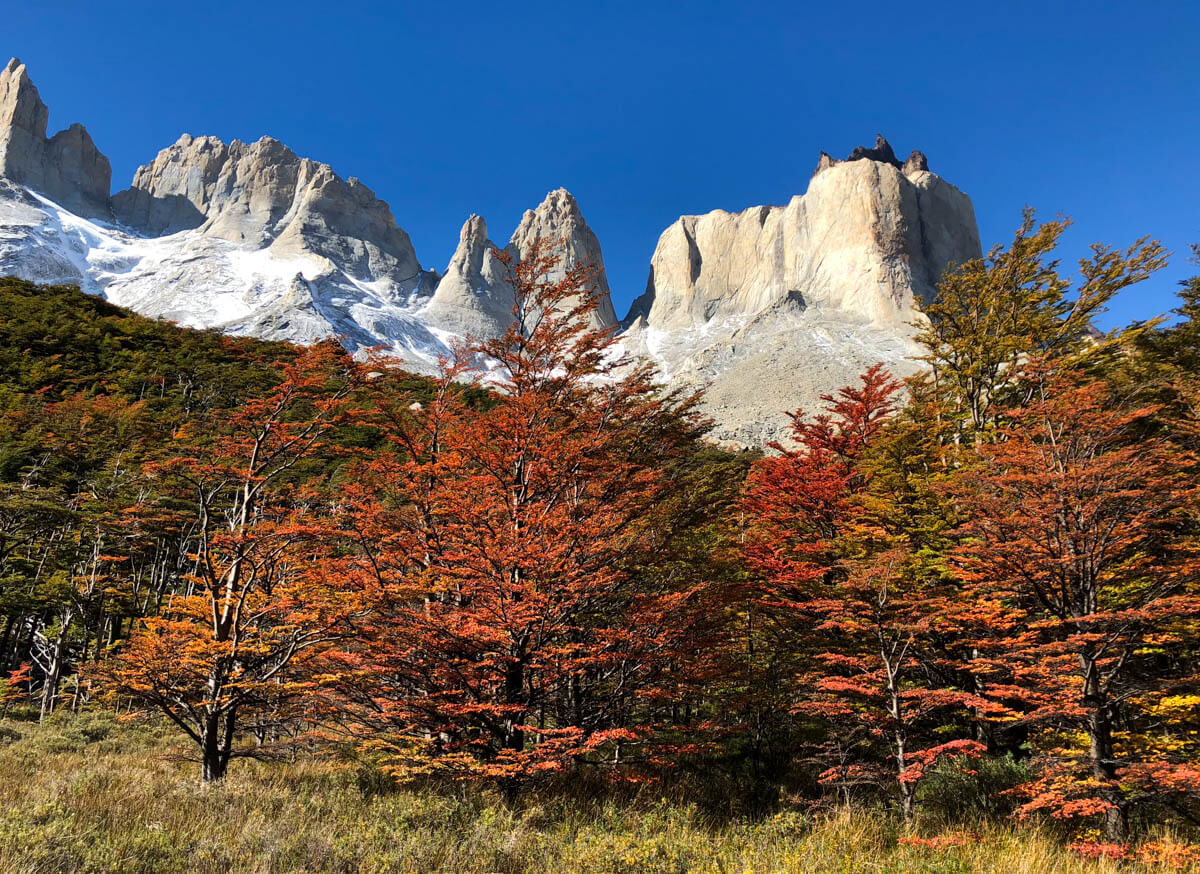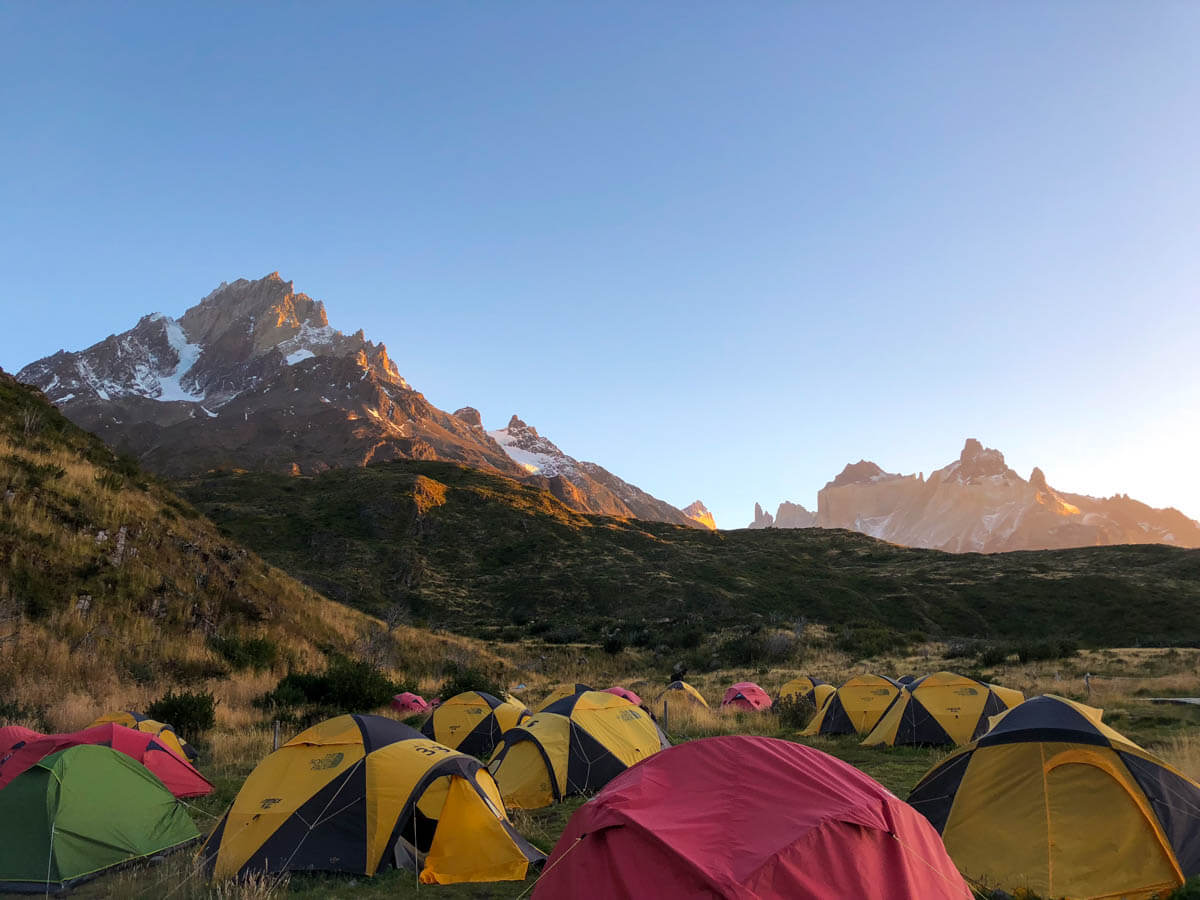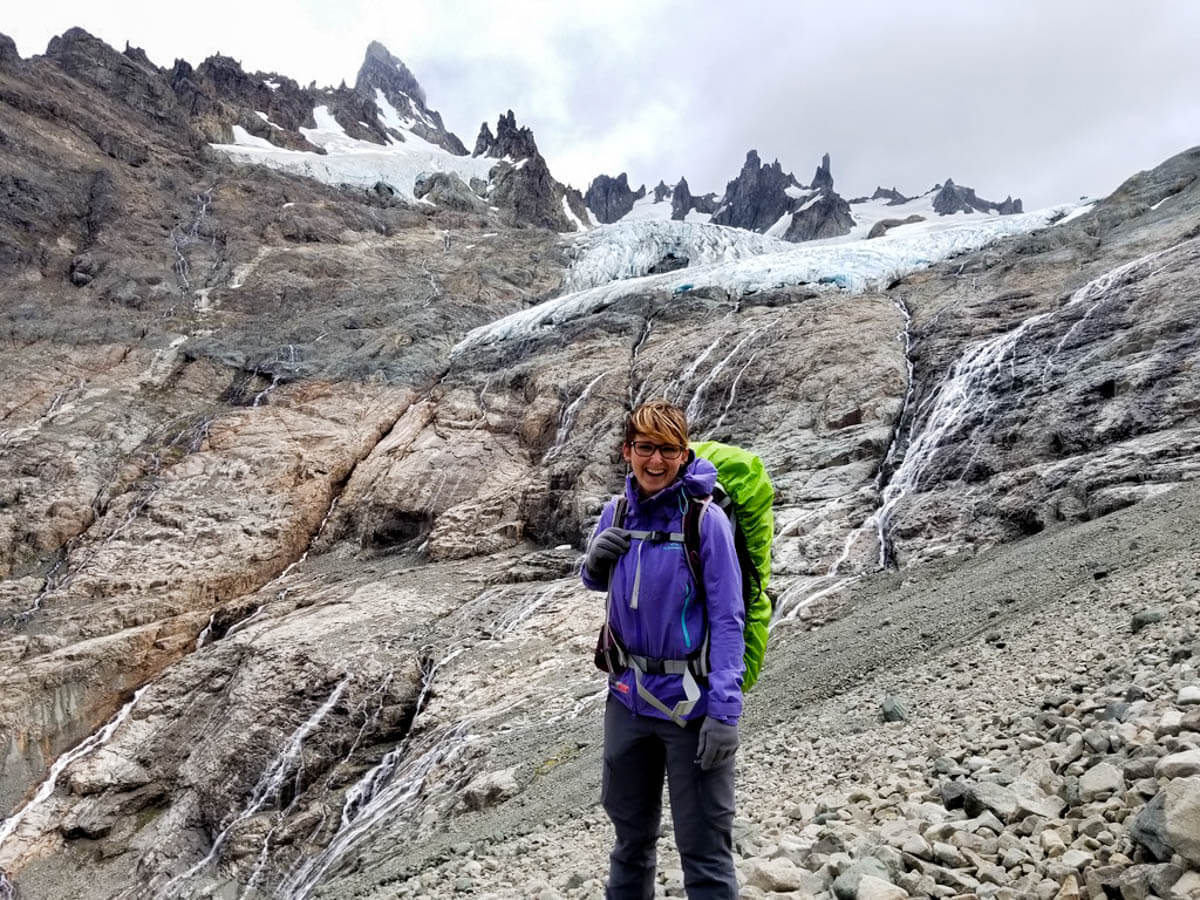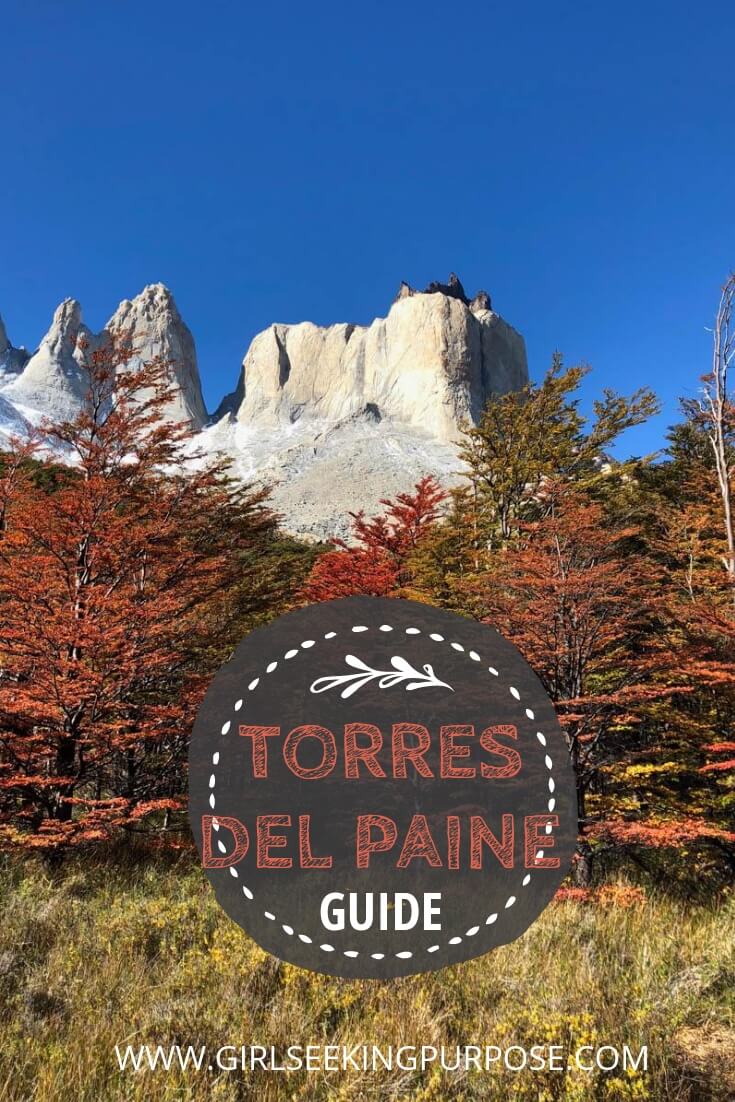This guide will tell you everything you need to know about completing the O Circuit or the W trek in Torres Del Paine, Patagonia. If you have questions about how to get there, what gear to pack, how much it will cost or what route you should take then this guide has you sorted. After trekking in various locations in Patagonia over a six week period, and completing the famous O Circuit I believe I’ve worked out a user friendly guide for all you should need to get to Torres Del Paine and complete either of the famous trails.
This post contains affiliate links, which means that if you follow a link for a product or service and make a purchase, I receive a small payment at no extra cost to you. I only recommend products or services that I have used, trust and would honestly recommend to my readers. Building affiliate links into my site will help keep my blog going and continue to allow me to produce the content that I hope you are all enjoying reading.
Puerto Natales – Home Base
Puerto Natales is the access town for the Torres Del Paine National Park. If you are planning to complete the O Circuit, the W Trek or any day hikes within the park then you will need to access the park from Puerto Natales. If you are completing one of the longer treks you will likely need to stay in Puerto Natales for one or two nights either side of your hike.
Getting There and Away
Depending whether you are travelling north or south, you will likely arrive to Puerto Natales either from Punta Arenas or El Calafate.
From Punta Arenas
Punta Arenas, in Chile is the major hub for transportation in and out of the Chilean side of Southern Patagonia. There are frequent buses to and from Puerto Natales and Punta Arenas on a daily basis throughout the peak and shoulder seasons with a variety of bus companies. The average price was around $8,000.00 CLP ($16.60 AUD) when I was there in March 2018. The tickets can be purchased at the bus terminal or online via companies such as Bus Bud. The bus journey usually takes about three hours.
From El Calafate
El Calafate, in Argentina is another regular destination before or after Torres Del Paine. It is home to the Perito Moreno glacier. It also contains the major airport for the Argentinian side of Southern Patagonia. You may have also visited El Chaltén on your way down to Torres Del Paine via El Calafate.
There are bus transfers to and from El Calafate to Puerto Natales but they are a little less frequent than the buses to Punta Arenas. The trip usually takes around five hours; however, this may vary due to the border crossing. The average price was around $900.00 ARS ($33.90) when I was there in March 2018.
Costs in Town
If you are travelling here from a major city such as Santiago or Buenos Aires then you will be a little shocked by the prices. Hostels, restaurants and even the supermarkets are a lot more expensive. Puerto Natales is in a pretty remote area. As it is also quite tourist oriented, expect to pay almost double for nearly everything. Try to adjust your travel plans and budget accordingly.
As always there are ways to minimise costs by camping, cooking your own meals or choosing a less expensive hostel. I invested in a good hostel during my stay as I knew I would trekking in the Torres Del Paine national park for 9 – 10 days and wanted a clean, comfy bed before and after the trek. This is a decision you need to make to suit yourself.
If you want to get an idea of what is available in Puerto Natales for accommodation, then have a quick look on Booking.com. I always find they offer the most rewards and discounts as a long term traveller and use them to book a lot of my accommodation while I travel.
Gear Options
Patagonia, and Torres Del Paine, are famous for their tumultuous and unpredictable weather. You can literally end up with four seasons in one day. You need to ensure you are adequately prepared for the wind, snow, rain, sun, and cold.
First and foremost, you will need to ensure your hiking tent is built to withstand the intense Patagonian winds of up to 160km/hr. It is also important to bring appropriate clothing
for the potential weather changes; think layers. A decent pair of hiking boots
that will offer you adequate support and protection is also essential. Lastly, having a good quality hiking specific backpack
will make all the difference while you are out there carrying everything you need to survive on your back.
BYO Gear
My first recommendation would be to bring your own hiking gear for Torres Del Paine. If you will be completing the O Circuit then hiring gear for the duration of a hike of this length will be very expensive. Having your own gear also means you can plan ahead for weight and packing, and you will also know that all of your gear is in working order.
I put together a thorough list of trekking specific gear in this hiking packing list post which applies for both The O Circuit and The W Trek in Torres Del Paine. The only difference is that you will need to increase or decrease your daily food depending on the length of your hike.
Gear Hire
If you are only coming to Patagonia to complete the W or the O and won’t get enough use out of your gear to justify purpose buying it all, then hiring gear is also an option. You will find gear hire stores, hostels that hire gear, and outdoor shops galore in Puerto Natales. You will most certainly be able to get all of the gear you need here before you start your trek.
Erratic Rock seem to be one of the most reliable places for gear hire, or at least a good starting point. They also offer a free talk at 3.00pm everyday about the routes, gear and what to expect.
Another idea is to ask the owner of your hostel if you need a particular item. They tend to have the most up to date information about the town and available options. That’s how I ended up scoring myself $15 AUD hiking poles for Torres Del Paine the day before I started the O Circuit. I then left them for someone else in the hostel to use once I was finished in Patagonia.
Torres Del Paine National Park
Getting There and Away
Into the Park
Buses run twice a day from Puerto Natales to the Torres Del Paine National Park for $7,500.00 CLP ($15.50 AUD).
- 7.20am – 1 hour 30 minutes
- 12.30pm – 1 hour 30 minutes
Shuttle buses then take you from the registration centre to the welcome centre near Refugio Central for $3,000.00 CLP ($6.20 AUD). You can walk this distance but there isn’t much to see and it isn’t really worth the time.
The shuttle times run according to the buses that drop you at the registration centre. They take no longer than 15 minutes to arrive at the beginning of the trails.
Leaving the Park
Shuttle buses run twice daily to take you from the welcome centre near Refugio Central to the registration centre for $3,000.00 CLP ($6.20 AUD).
- 2.00pm – 15 minutes
- 7.00pm – 15 minutes
Buses run twice a day from the Torres Del Paine National Park to Puerto Natales for $7,500.00 CLP ($15.50 AUD).
- 2.30pm – 1 hour 30 minutes
- 7.45pm – 1 hour 30 minutes
Booking
You need to book in advance for all of your camp sites and / or refugio stays in Torres Del Paine. This is especially the case if you want to tackle the O Circuit. They have a checkpoint between the Seron and Dickson campsite where they check Passports and bookings before you continue on. If you don’t have the required booking then they turn you around to hike back to the start.
Even during the shoulder seasons almost all of the refugios and camp sites were full. You won’t get very far in the park without a booking so it is better to organise it well in advance or at least have it sorted in Puerto Natales before you get on the bus to the park.
It is also good to remember that the limits are there for a reason. Restrictions on popular hikes help to preserve the trails from overuse and to limit the number of people at each camp site and refugio so that they can be properly maintained. Before you try to cheat the system, which is very common during peak season, think about the impacts of overcrowding to the gorgeous natural environment of the Torres Del Paine National Park.
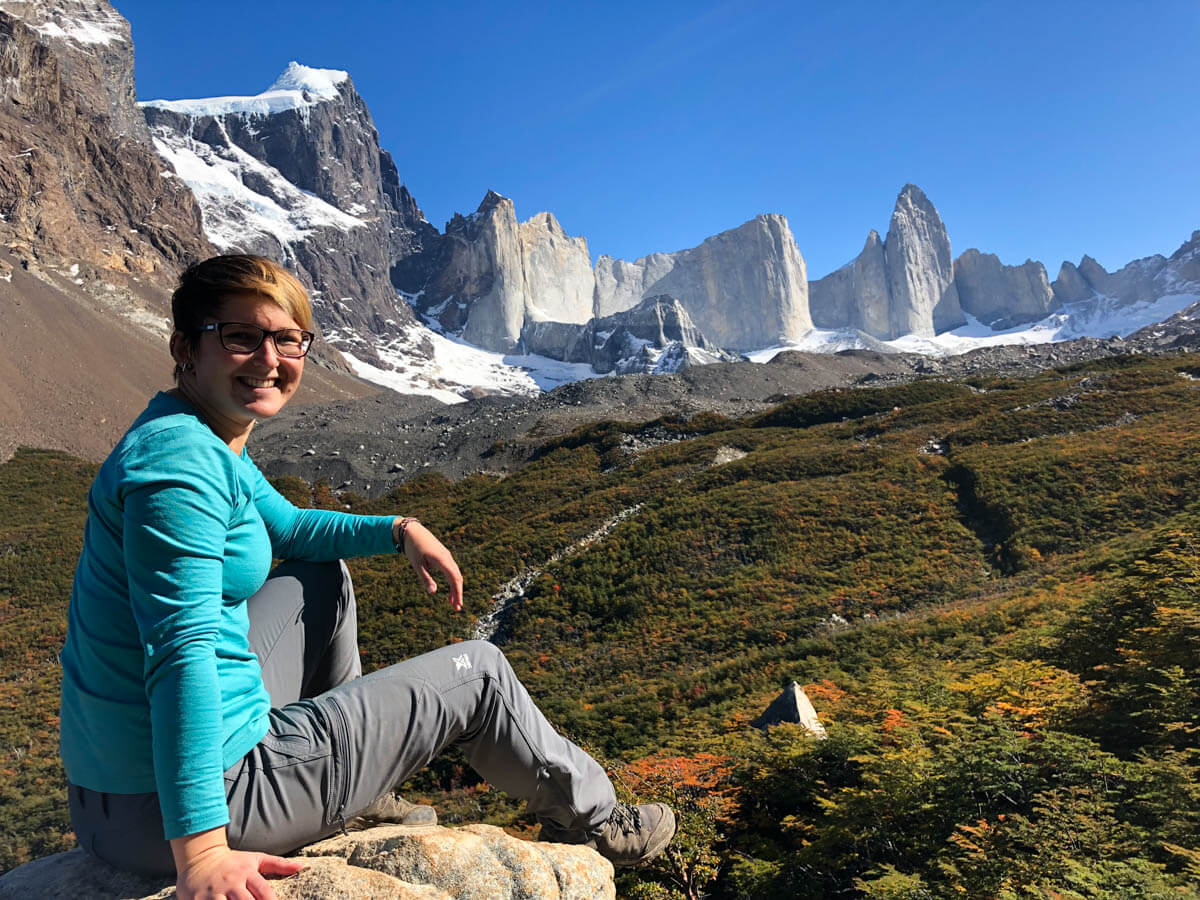
Hopefully you are lucky enough to have a clear day like this while you are out in the Torres Del Paine National Park.
How to Book
To book in advance you need to head online once you have decided on your preferred dates and camp sites. The three companies you will need to book through are Fantastico Sur, and Vertice Patagonia for the paid campsites and CONAF for the free national park campsites. When I completed my bookings I tried to do them all at the same time to ensure I received all of the required dates for the circuit.
You are able to email them if you have made an error or need to alter dates, but it is a lot easier to get it right the first time. I booked around four months in advance which gave me quite a lot of flexibility in dates. I was also going at the end of the season in the last week of March. If you want to book for the peak Summer dates then you need to book as early as possible. Check the websites to find out when bookings open, but it is usually around six months in advance.
What if it is Booked Out
In the event you haven’t booked in advance or you left it too late and the online bookings say it is full, you can still head to Puerto Natales in hopes of there being availability. Once there you can attend the offices in person for the paid sites and try to make your bookings. When I was in Torres Del Paine in March, the online system was showing as fully booked. When my friends attended the offices there was actually still plenty of space.
There are also a few hostels that help you out in organising last minute bookings. They will help you work out what sites are still available. They can then assist you in building a custom hiking route to suit those sites. It may mean that you have longer hiking days or you have to skip some of your preferred viewpoints, but the option is still there.
Day Trips or Single Night Stays
If all else fails, you can still complete day trips into Torres Del Paine to see some of the famous sections of the park, including the Towers and the French Valley. It will take around 3 – 4 hours of driving there and back for a day trip though. You will need to factor this in and potentially look at trying to book one night in the park at whichever site or refugio has space to give you more time.
Hire Options
If you haven’t brought your own gear and you don’t want to hire it in Puerto Natales then there is a third option. You can hire individual items, or your entire camping setup at each refugio on the W and on most of the O. The free campsites such as Paso and Italiano do not offer these options but the rest do. This is by far the most expensive option of all of the gear choices but it may be suitable for certain reasons.
The main benefit to hiring at each Refugio is that you don’t have to carry the gear from campsite to campsite. In this sense it makes the trail accessible to everyone, including people who don’t think they can carry all of their own gear or to people who may not have trekking specific backpacks while in Patagonia and therefore are unable to fit everything they need.
The other good use is if you have any gear malfunctions along the way or realise halfway through that your sleeping bag just isn’t warm enough you have the option to hire certain items. I met one guy who ended up hiring a sleeping bag for the entire O Circuit after freezing in his own bag on the first night. It’s expensive but the option is there. To clarify, I took all of my own gear from home which was by far the most cost effective as I used it throughout my six weeks in Patagonia as well as during my time in Torres Del Paine.
The O Circuit – Suggested Routes
Route Options
The following are suggested options for three different itineraries on the O Circuit. The normal route is 8 days / 7 nights. There is an extended option of 9 days / 8 nights, or the quick version of 7 days / 6 nights. For a more detailed summary of the trail days, with explanation and specific hiking instructions please refer to my Complete Guide to hiking The O Circuit that will be published next week.
Starting Point
You should be able to complete the O Circuit in eight to nine days. This is dependant on if the weather allows you to go over the John Gardner Pass. A reminder that you can only hike the O Circuit in a counterclockwise direction. You can start the O Circuit at either the Welcome Centre with the W section at the end, or from Paine Grande with the W at the beginning. Most of the people I met, myself included, started from the Welcome Centre. This allows you to end your circuit with the hike up to see the famous towers that Torres Del Paine is most well known for.
I also note that the free CONAF campsites have limited facilities and no refugio, which was suitable for me but is not to everyones’ taste. I have provided alternative options to stay in the surrounding camps if this is not your preference.
8 Days / 7 Nights – Recommended
- Day 1 – Camp Seron (No Refugio) Approximately 4 – 5 hours and 9km.
- Day 2 – Camp Dickson (Refugio also) Approximately 6 – 7 hours and 18km.
- Day 3 – Camp Los Perros (No Refugio) Approximately 5 hours and 10km.
- Day 4 – Camp Grey (Refugio also) *if bad weather you can stop at Camp Paso Approximately 9 – 11 hours and 14.5km.
- Day 5 – Camp Paine Grande (Refugio also) Approximately 3 – 4 hours and 11km.
- Day 6 – Italiano / Francais (Free site or Paid site) Approximately 2 hours and 7.5km to Italiano. French Valley – Total 5 hours and 10km return.
- Day 7 – Chileno / Central (Paid site with full board / Paid site with cooking allowed) Chileno – Approximately 6.5 hours and 22km from Italiano to Chileno. Or approximately 6 hours and 20km from Francais to Chileno. Central – Approximately 6 hours and 22km from Italiano to Central. Approximately 5.5 hours and 20km from Francais to Central.
- Day 8 – Base de la Torres and then Puerto Natales Approximately 4 hours and 8km return from Chileno to the base of the towers and back. Approximately 8 hours and 18km return from Camp Central (Refugio Torre) to the base of the towers and back.
9 Days / 8 Nights – Extended Route
- Day 1 – Camp Seron (No Refugio) Approximately 4 – 5 hours and 9km.
- Day 2 – Camp Dickson (Refugio also) Approximately 6 – 7 hours and 18km.
- Day 3 – Camp Los Perros (No Refugio) Approximately 5 hours and 10km.
- Day 4 – Camp Grey (Refugio also) *if bad weather stop at Camp Paso Approximately 9 – 11 hours and 14.5km.
- Day 5 – Camp Paine Grande (Refugio also) Approximately 3 – 4 hours and 11km.
- Day 6 – Italiano / Francais (Free site or Paid site) Approximately 2 hours and 7.5km to Italiano. French Valley – Total 5 hours and 10km return.
- Day 7 – Chileno / Central (Paid site with full board / Paid site with cooking allowed) Chileno – Approximately 6.5 hours and 22km from Italiano to Chileno. Or approximately 6 hours and 20km from Francais to Chileno. Central – Approximately 6 hours and 22km from Italiano to Central. Approximately 5.5 hours and 20km from Francais to Central.
- Day 8 – Base de la Torres and then Puerto Natales Approximately 4 hours and 8km return from Chileno to the base of the towers and back. Approximately 8 hours and 18 km return from Camp Central (Refugio Torre) to the base of the towers and back.
- Day 9 – Puerto Natales Bus back to town.
7 Days / 6 Nights – Minimum
- Day 1 – Camp Seron (No Refugio) Approximately 4 – 5 hours and 9km.
- Day 2 – Camp Los Perros via Camp Dickson (No Refugio) Approximately 11 – 12 hours and 28km.
- Day 3 – Camp Grey (Refugio also) *if bad weather you can stop at Camp Paso Approximately 9 – 11 hours and 14.5km.
- Day 4 – Camp Paine Grande (Refugio also) Approximately 3 – 4 hours and 11km.
- Day 5 – Italiano / Francais (Free site or Paid site) Approximately 2 hours and 7.5km to Italiano. French Valley – Total 5 hours and 10km return.
- Day 6 – Chileno / Central (Paid site with full board / Paid site with cooking allowed) Chileno – Approximately 6.5 hours and 22km from Italiano to Chileno. Or approximately 6 hours and 20km from Francais to Chileno. Central – Approximately 6 hours and 22km from Italiano to Central. Approximately 5.5 hours and 20km from Francais to Central.
- Day 7 – Base de la Torres and Central Approximately 4 hours and 8km return from Chileno to the base of the towers and back. Approximately 8 hours and 18 km from Camp Central (Refugio Torre) to the base of the towers and back.
The W Trek – Suggested Routes
The W can be completed in either direction, either beginning at Paine Grande or Central. So if you would prefer to start at Camp Central then just reverse the camping route suggested below. The hours hiked may vary as I have only hiked the W from Paine Grande to Central as part of the O Circuit. The W can be comfortably completed in 5 – 6 days. You can also shorten this hike significantly if you are a fast hiker or are on a tighter schedule and are happy to exclude some of the return hikes to view points.
6 Days / 5 Nights
- Day 1 – Camp Grey (Camp and Refugio) Approximately 3.5hours and 11km to Camp Grey and then varied times and distances to the mirador from Grey to Paso.
- Day 2 – Paine Grande (Camp and Refugio) Approximately 3.5 hours and 11km.
- Day 3 – Italiano / Francais (Free camp sites and Paid camp sites) Approximately 2 hours and 7.5km to Italiano. French Valley – Total 5 hours and 10km return.
- Day 4 – Chileno / Central (Free/Paid site to Full board / Cooking allowed site) Approximately 6.5 hours and 22km from Italiano to Chileno. Or approximately 6 hours and 20km from Francais to Chileno. Approximately 6 hours and 22km from Italiano to Central. Approximately 5.5 hours and 20km from Francais to Central.
- Day 5 – Base de la Torres and Central Approximately 4 hours and 8km from Chileno to the base of the towers and back. Approximately 8 hours and 18km from Camp Central (Refugio Torre) to the base of the towers and back.
- Day 6 – Puerto Natales Bus back to town.
5 Days / 4 Nights
- Day 1 – Camp Grey (Camp and Refugio) Approximately 3.5hours and 11km to Camp Grey and then varied times and distances to the mirador from Grey to Paso.
- Day 2 – Paine Grande (Camp and Refugio) Approximately 3.5 hours and 11km.
- Day 3 – Italiano / Francais (Free camp sites and Paid camp sites) Approximately 2 hours and 7.5km to Italiano. French Valley – Total 5 hours and 10km return.
- Day 4 – Chileno / Central (Free/Paid site to Full board / Cooking allowed site) Approximately 6.5 hours and 22km from Italiano to Chileno. Approximately 6 hours and 20km from Francais to Chileno. Or approximately 6 hours and 22km from Italiano to Central. Approximately 5.5 hours and 20km from Francais to Central.
- Day 5 – Base de la Torres and Puerto Natales Approximately 4 hours and 8km from Chileno to the base of the towers and back. Approximately 8 hours and 18km from Camp Centra (Refugio Torre) l to the base of the towers and back.
When to Go
Season
Torres Del Paine is open from September to April each year but can close early depending on the weather. Peak season is from November to February. This is when the park is the busiest and most expensive. Some people would say that everything outside of December and January is shoulder season; however, the prices and numbers of people do significantly drop once it gets to March, and prior to November. I note it is possible to hike during the winter months. This is usually only if you have specialised expedition experience and with prior approval.
Shoulder season is in October and March and is when I would recommend attending. If you are really concerned about the weather you can aim for the peak season. If you don’t mind a bit of snow and are prepared for experiencing the famous Patagonian winds then the shoulder season is the way to go. We were lucky enough to see the Autumn colours roll in on the last week of March too which was pretty spectacular. I imagine October is equally as beautiful given that it is Spring.
Limits for the O Circuit
Keep in mind that if you want to complete the O Circuit then you have to attend between October and March. The O Circuit is not open in September or April like the rest of the park. The O Circuit closes at the end of March and then only the W or day hikers are allowed into Torres Del Paine.
To be honest, I wouldn’t like to be going over the John Gardner Pass any later in the year anyway as the weather up there can get pretty crazy. We already had knee to thigh deep snow in the last week of March of 2018 while going over the pass. It had also been closed for two weeks prior to our hike due to bad weather.
What to Pack
This is usually a big question for a lot of people setting off on a multi-day trek in Patagonia. Deciding what to pack for the O Circuit or the W in Torres Del Paine can be a little overwhelming. I have put together a hiking packing post about what to pack for any multi-day hike, with Patagonia specifically in mind. It covers clothing, shelter, trekking gear, food and safety gear. Once you’ve read that in conjunction with this post, then you should be ready to get out there and hit the trail.
If you are planning on completing any day hikes in the park, then this is what I would usually take on a day hike in alpine environments: –
- 18L Osprey Ultralight Stuff Pack
or Osprey 20L Tempest day pack
- Fujifilm X-T2 Camera
, a wide angle lens
and a general purpose / portrait lens
, and accessories
- CamelBak water reservoir
/ Nalgene water bottle
- Snacks (muesli bars, dried fruit and nut, Clif bars
and / or fresh fruit or snacks depending on the length of the hike)
- Water/windproof jacket if the weather turns
— this jacket from Arc’teryx
is excellent quality, or or a jacket from The North Face
- XT Ultralight Packable Down Jacket or Arc’teryx fleece
in case it will be cold at the summit or if completing a sunrise hike
- Headlamp
in case you lose light
- Phone for emergencies and maps.me
- First Aid Kit
- Personal Locator Beacon (PLB)
— depending on how remote your hike will be, although I always carry one regardless
Travel Insurance
No outdoor hiking itinerary would be complete without travel insurance. While you can take every precaution under the sun to ensure the safety and security of yourself and your belongings, you just never know what is going to happen. That is why I always make sure I have adequate travel insurance before I travel or hike anywhere. For my last three long term adventure trips, my preferred travel insurer has been World Nomads.
If you decide to use them for your next trip or hike and you would like to support this blog, then please make your purchase through the following link and I will receive a small commission at no extra cost to you. As always, make sure you read their product disclosure statement and check that it is suitable for your needs before proceeding.
More of Patagonia
If you have more time up your sleeve, then I highly recommend checking out some of the other regions in Patagonia. My two favourite hikes in all of Patagonia are the treks to Cerro Castillo and to Cerro Tronador. Both of these are located in areas outside of the Torres Del Paine National Park, so you would need to include them in a longer Patagonian Itinerary.
If you will be in Patagonia for more than a week or two, then you should definitely head to Bariloche, Pumalin Park, the Carretera Austral, El Chaltén and El Calafate. My time in Patagonia was both challenging, and rewarding and was full of revelations. It deserves as much time as you can possibly afford it.
Save it For Later
If you liked this post then please save it for later on Pinterest. You can also share it with any friends who are considering heading to Torres Del Paine in Patagonia.
If you have any questions then please ask me in the comments section and I will answer them to the best of my knowledge. Patagonia will change your life!
--Girl Seeking Purpose
